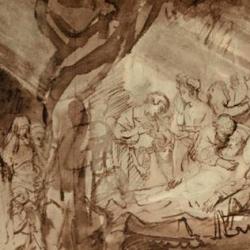What is the literal sense? In the current issue of the IJST , R. R. Reno suggests that it involves attending to the text: “We want to bring out minds and hearts into obedience to God’s Word rather than to float in a spiritual world of our imaginings . . . . If we are to believe what the Bible says, then we must attend to what the Bible says.” Attending to the text is not, however, what classic Protestant theology has meant by interpreting according to the literal sense. Reno offers the example of Charles Hodge “redefining the literal sense as something other than the literal sense.” It works like this:
Following Protestant tradition, Hodge argued that the Scriptures are perspicuous and the literal sense immediately accessible to anyone: “The Bible is a plain book . . . It is intelligible by the people.” For Hodge, Scripture is the standard of saving truth and thus, Reno suggests, it ought to follow “that what the Bible says ought to govern our faith.”
But this is not what Hodge finally claims:
“As Hodge observes, ‘If the Scriptures be a plain book, and the Spirit performs the functions of a teacher to all the children of God, it follows inevitably that they must agree in all essential matters in their interpretation of the Bible.’ In other words, because the literal sense must be available as a criterion for true doctrine, it is available, and as available, effective in government the faith of believers. “And from that fact,’ Hodge continues,’ it follows that for an individual Christian to dissent from the faith of the universal Church (i.e., the body of true believers), is tantamount to dissenting from the Scriptures themselves.’ What this means is that the confessional statements and authoritative doctrines of the Reformation constitute the proper authority for determining what the Bible really says, the literal sense.”
Reno makes a startling comparison of Hodge and the critical Catholic scholar Joseph Fitzmyer. Both conclude that “the literal sense is paradoxically not what the Bible says. Or more accurately, we derive our assurance that we know what the Bible really says by recourse to something other than what the Bible says – to scholarly methods for the modern biblical critic and to confessional statements for the classical Protestant theologian.”
Reno advocates the obvious method of looking at the Bible to determine the literal sense. It is well to remember at this point that Reno is a Catholic.
Now, I’m not sure that Hodge actually takes the last step that Reno attributes to him – namely, that the perspicuous literal sense of Scripture is found in the confessional documents of the Reformation. But if Hodge doesn’t, many do. And in effect, on this argument, we need not look to the Bible itself to determine what the Bible says. Because it is clear, its main teachings are universally accepted, and we can find them in the confessions. The argument is bound up with an ecclesiology: If the “universal church” includes people who dissent from the Reformation confessions, then the theory breaks apart. There is then no consensus on the literal sense.
If Reno’s summary represents “classical Protestantism,” it’s no wonder the “Federal Vision” has been controversial. It hammers at the two planks of the argument: It insists that we look to the Bible to discover what the Bible says, and it insists too that the church is far, far bigger than the “body of true believers” who affirm the Reformation confessions.











